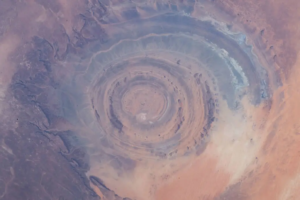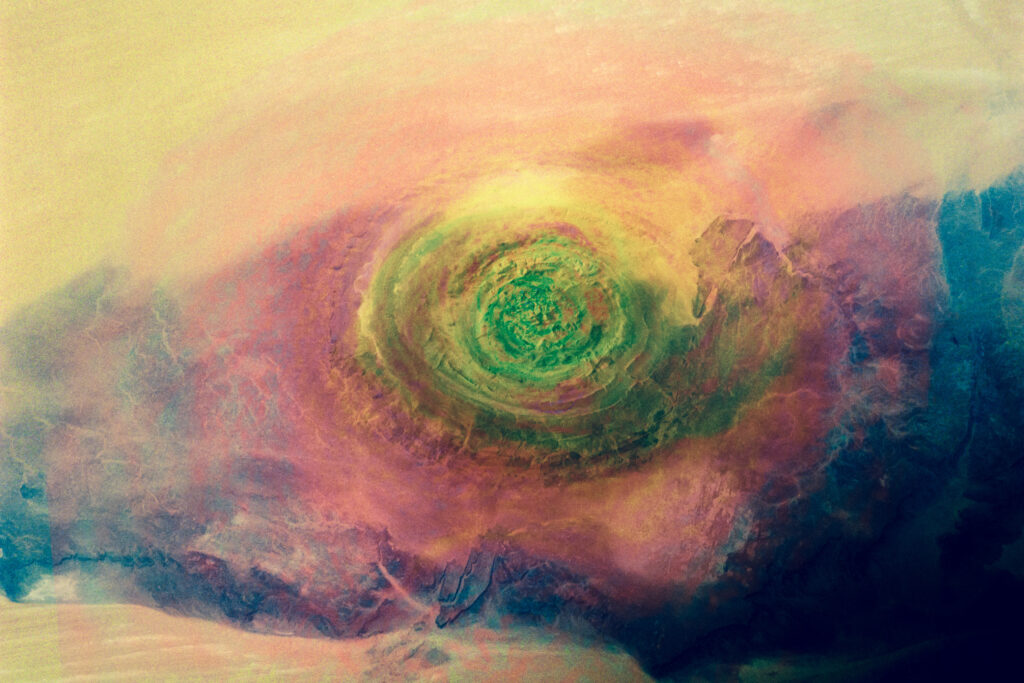The ‘Eye of Sahara’ is one of the most breathtaking natural structures in the world. The 40 Km structure, in the country of Mauritania indicates almost one billion years of different geological activity. Thus, its presence in the western part of the Sahara desert can open doors to the answers related to the condition of our planet in the past. Not only that, the different theories behind its formation and accumulation have opened up room for new geological research.
The Eye of Sahara
The Sahara desert is the biggest desert on Earth and is full of mysteries and geological secrets. One such prominent structure is the “Eye of Sahara.” Although visible only from space, the great structures provide some of the most useful insights regarding the geology of the planet in the past century. So, let’s take a closer look at this magnificent structure and find out more about it.

Prominent Features of Eye of Sahara
The Eye of Sahara is a richat structure and has the shape of a dome. It’s spread across 40 miles on the western side of the great desert. Moreover, the ongoing wind in the region makes the structure available for viewing from outer space.
The initial verdict around the ring-like structure suggested it was a crater from an asteroid impact. However, the studies suggest something very different and enlightening for normal science enthusiasts.
Reason: Geologic Uplift
The structure began taking its form when the supercontinent Pangea still existed. Additionally, the volcanic activity of the place started to push an enormous amount of magma to the surface. Due to this, the limestone present on the surface melted which led to further process.
All this process can be vaguely termed under the phenomenon of Geologic uplift. While many different scientific terminologies and factors played an important role in the development of the eye of the Sahara—it’s the most layman-explained.
Phreatic Eruption
Upon reaching the surface of the place, the volcanic magma interacted with water which was turned into steam—causing a big explosion. The resultant was a 2Km crater which was observable once the ashes and debris were cleared by the winds.
Over time the soft rocks vanished due to corrosion and are most like present on the outside of the ring structure. Whereas, the centre of the ring comprises the oldest rocks and elements of the region, hardened over time.
Viewing And Visibility
It’s not possible to view the structure from the surface as it’s massive. Thus, one needs to be in space or at least near the atmosphere to get a glimpse of the Eye of the Sahara. Even if there are tons of pictures available online, people still visit the place for different purposes.
Conclusion
The Eye of Sahara, a 40 km-long structure in Mauritania, is a richat structure that reveals almost one billion years of geological activity. Its formation was attributed to geologic uplift, volcanic activity, and pyretic eruption. The structure is visible only from space and is believed to be a 2 km crater. Despite its massive size, the Eye of Sahara remains a popular tourist attraction.
Frequently Ask Questions (FAQs)
What caused the Eye of the Sahara?
Initially, it was believed that the structure resulted from an asteroid impact. However, from recent studies, scientists concluded that the structure is a geologic uplift.
What country is Eye of the Sahara in?
The richat structure is present in Mauritania—especially in Ouadane in the Adrar Region.
Has anyone ever visited the Eye of the Sahara?
Yes, many scientists, tourists, explorers, researchers and journalists visit the region annually.
How old is Eye of the Sahara?
Studies estimate that the sedimentary rock structure, known as the Eye of Sahara belongs to the Proterozoic era. Thus, can be over 600 million years old.

